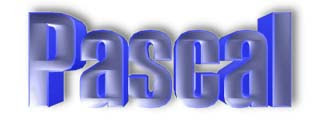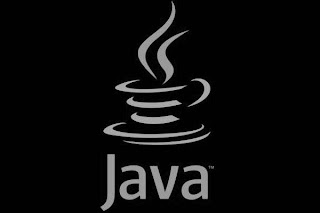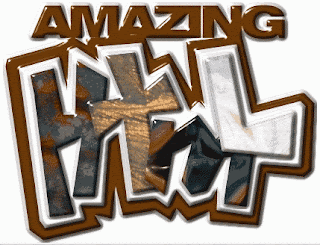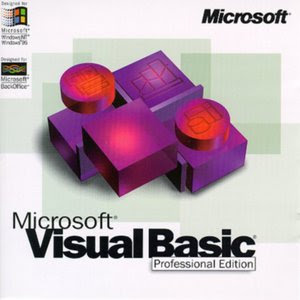www.google.com
www.wikipedia.com
www.daniweb.com
www.thetechherald.com
Jumat, 16 Januari 2009
PASCAL

PASCAL
What is Pascal?
Pascal is an influential imperative and procedural programming language, designed in 1968/9 and published in 1970 by Niklaus Wirth as a small and efficient language intended to encourage good programming practices using structured programming and data structuring.
History
Pascal is based on the ALGOL programming language and named in honor of the French mathematician and philosopher Blaise Pascal. Wirth subsequently developed the Modula-2 and Oberon, languages similar to Pascal. Before, and leading up to Pascal, Wirth developed the language Euler, followed by Algol-W.
Initially, Pascal was largely, but not exclusively, intended to teach students structured programming. Generations of students have "cut their teeth" on Pascal as an introductory language in undergraduate courses. Variants of Pascal have also frequently been used for everything from research projects to PC games and embedded systems. Newer Pascal compilers exist which are widely used.
Pascal was the primary high-level language used for development in the Apple Lisa, and in the early years of the Mac; parts of the original Macintosh operating system were hand-translated into Motorola 68000 assembly language from the Pascal sources. The popular typesetting system TeX by Donald E. Knuth was written in WEB, the original literate programming system, based on DEC PDP-10 Pascal, while an application like Total Commander was written in Delphi (i.e. Object Pascal).
Areas of use
Pascal is used to develop applications in a number of different areas. Some of them are listed below:
* Accounting
* Business
* Commerce
* Education
* Law
* Medicine
* Research
* Science
The Advantages
-Debugging is easier. If the procedure is well written, it will do one and only one thing, making it easier to check
-Lower maintenance cost. If you have the same code spread along your code, you have to remember where it is located and fix or at least cut and paste it several times
-You can reuse the code. For example, you may place your procedures in a library and later use it in another program.
-Greater understanding. Since the procedure is well defined and documented, someone interested won't have to scroll through the whole source in order to find the code he/she wants
-Easier tuning. Performance usually comes from changing small pieces of code. With procedures these pieces are naturally separated and side-effects from changing variables or code are less likely to happen.
The Disadvantages
-Not as popular as C – so not as many compilers.
-A bit wordy – it was originally intended as a teaching language.
-Not as flexible as C.
The Syntax
while a <> b do writeln('Waiting');
if a > b then writeln('Condition met')
else writeln('Condition not met');
for i := 1 to 10 do writeln('Iteration: ', i:1);
repeat
a := a + 1
until a = 10;
case i of
0: write('zero');
1: write('one');
2: write('two')
end;
JAVA

JAVA
What is JAVA ?
Java is a programming language originally developed by Sun Microsystems and released in 1995 as a core component of Sun Microsystems' Java platform. The language derives much of its syntax from C and C++ but has a simpler object model and fewer low-level facilities. Java applications are typically compiled to bytecode that can run on any Java virtual machine (JVM) regardless of computer architecture.
History
James Gosling initiated the Java language project in June 1991 for use in one of his many set-top box projects. The language, initially called Oak after an oak tree that stood outside Gosling's office, also went by the name Green and ended up later renamed as Java, from a list of random words.[5] Gosling aimed to implement a virtual machine and a language that had a familiar C/C++ style of notation.
Sun released the first public implementation as Java 1.0 in 1995. It promised "Write Once, Run Anywhere" (WORA), providing no-cost run-times on popular platforms. Fairly secure and featuring configurable security, it allowed network- and file-access restrictions. Major web browsers soon incorporated the ability to run secure Java applets within web pages, and Java quickly became popular. With the advent of Java 2 (released initially as J2SE 1.2 in December 1998), new versions had multiple configurations built for different types of platforms. For example, J2EE targeted enterprise applications and the greatly stripped-down version J2ME for mobile applications. J2SE designated the Standard Edition. In 2006, for marketing purposes, Sun renamed new J2 versions as Java EE, Java ME, and Java SE, respectively.
In 1997, Sun Microsystems approached the ISO/IEC JTC1 standards body and later the Ecma International to formalize Java, but it soon withdrew from the process. Java remains a de facto standard, controlled through the Java Community Process. At one time, Sun made most of its Java implementations available without charge, despite their proprietary software status. Sun generated revenue from Java through the selling of licenses for specialized products such as the Java Enterprise System. Sun distinguishes between its Software Development Kit (SDK) and Runtime Environment (JRE) (a subset of the SDK); the primary distinction involves the JRE's lack of the compiler, utility programs, and header files.
On 13 November 2006, Sun released much of Java as free and open source software under the terms of the GNU General Public License (GPL). On 8 May 2007 Sun finished the process, making all of Java's core code free and open-source, aside from a small portion of code to which Sun did not hold the copyright.
Areas of Use
Java is used to develop applications in a number of different areas. Some of them are listed below:
* Accounting
* Business
* Commerce
* Consulting
* Education
* Law
* Marketing and Sales
* Research
* Science
* etc
The Advantages
-can solve the problem in our life
-can be used in Symbian series
-low of memory
-Overcame and avoided the problem crash in programming
The Disadvantages
-difficult syntax
-must save the file text with .(dot)java extension
The Syntax
/**
* Outputs "Hello, World!" and then exits
*/
public class HelloWorld {
public static void main(String[] args) {
System.out.println("Hello, World!");
}
}
---------------------------------
/*and for example the other*/
---------------------------------
import javax.swing.JFrame;
import javax.swing.JMenu;
import javax.swing.JMenuBar;
import javax.swing.JMenuItem;
public class Micek1
{
public static void main(String[]args)
{
JFrame frame=new JFrame("HAHA");
JMenuBar menuBar=new JMenuBar();
JMenu menu=new JMenu("File");
JMenuItem itemOpen=new JMenuItem("open");
JMenuItem itemClose=new JMenuItem("Close");
frame.setJMenuBar(menuBar);
menuBar.add(menu);
menu.add(itemOpen);
menu.add(item.Close);
frame.setDefaultCloseOperation(JFrame.EXIT_ON_CLOSE);
frame.setSize(400,200);
frame.setVisible(true);
}
}
HTML

HTML
What is HTML ?
HTML, an initialism of HyperText Markup Language, is the predominant markup language for Web pages. It provides a means to describe the structure of text-based information in a document — by denoting certain text as links, headings, paragraphs, lists, and so on — and to supplement that text with interactive forms, embedded images, and other objects.
History of HTML
In 1980, physicist Tim Berners-Lee, who was an independent contractor at CERN, proposed and prototyped ENQUIRE, a system for CERN researchers to use and share documents. In 1989, Berners-Lee and CERN data systems engineer Robert Cailliau each submitted separate proposals for an Internet-based hypertext system providing similar functionality. The following year, they collaborated on a joint proposal, the WorldWideWeb (W3) project,[1] which was accepted by CERN.
Areas Of Use
HTML is used to develop applications in a number of different areas. Some of them are listed below:
* Accounting
* Business
* Commerce
* Consulting
* Education
* Research
The Advantages
-to build a content from website,weblogsite(BLOG)
-the logic element tag in HTML is as not difficult as C++, JAVA, C, Pascal, Delphi, etc
The Disadvantages
-it was difficult in writing of this program
-need more spaces of memory
The Syntax
/* html open */
/*tag open body */
/* tag ol open */
1. vegetables
/* content of list */
2. milk
3. fruits
/* tag ol close */
/* tag body close */
/*html close */
C++

C++
What is C ?
C is an imperative (procedural) systems implementation language. It was designed to be compiled using a relatively straightforward compiler, to provide low-level access to memory, to provide language constructs that map efficiently to machine instructions, and to require minimal run-time support. C was therefore useful for many applications that had formerly been coded in assembly language.
Why is C popular?
In computing, C is a general-purpose computer programming language originally developed in 1972 by Dennis Ritchie at the Bell Telephone Laboratories for use with the Unix operating system.
Although C was designed for implementing system software, it is also widely used for developing application software.
It is widely used on many different software platforms and computer architectures, and several popular C compilers exist. C has greatly influenced many other popular programming languages, most notably C++, which originally began as an extension to C.
Areas of Use
C++ is used to develop applications in a number of different areas. Some of them are listed below:
* Commerce
* Education
* Marketing and Sales
* etc
History
The initial development of C occurred at AT&T Bell Labs between 1969 and 1973; according to Ritchie, the most creative period occurred in 1972. It was named "C" because many of its features were derived from an earlier language called "B", which according to Ken Thompson was a stripped-down version of the BCPL programming language.
The origin of C is closely tied to the development of the Unix operating system, originally implemented in assembly language on a PDP-7 by Ritchie and Thompson, incorporating several ideas from colleagues. Eventually they decided to port the operating system to a PDP-11. B's lack of functionality to take advantage of some of the PDP-11's features, notably byte addressability, led to the development of an early version of the C programming language.
The original PDP-11 version of the Unix system was developed in assembly language. By 1973, with the addition of struct types, the C language had become powerful enough that most of the Unix kernel was rewritten in C. This was one of the first operating system kernels implemented in a language other than assembly. (Earlier instances include the Multics system (written in PL/I), and MCP (Master Control Program) for the Burroughs B5000 written in ALGOL in 1961.)
The Advantages
-Compiled language - always runs fast.
-Standardized language (ANSI)- easier to port to different compilers / target devices.
-Many compilers available.
-Many in built functions (depending on compiler).
-Very popular – large user base with many example programs.
-Used in many different industries.
-Usable at the hardware level as well as higher abstraction levels (although C++ is better for very abstracted programming models).
The Disadvantages
-Hard to learn at first.
-Strong type checking means you spend time pleasing the compiler (although this protects you from making errors).
The Syntax
long int SomeFunction();
/* int OtherFunction(); */
/* int */ CallingFunction()
{
long int test1;
register /* int */ test2;
test1 = SomeFunction();
if (test1 > 0)
test2 = 0;
else
test2 = OtherFunction();
return test2;
}
VISUAL BASIC

Visual Basic
What is Visual Basic?
Visual Basic is a "visual programming" environment for developing Windows (also Web now) applications. Visual Basic makes it possible to develop complicated applications very quickly. The programmer designs windows graphically, drags program elements from the Visual Basic Toolbox and writes basic code for each element. Visual Basic is "event-driven" which means that procedures are called automatically when the end user chooses menu items, clicks the mouse, moves objects on the screen, etc.
Why is Visual Basic popular?
Programmers have undergone a major change in many years of programming various machines. For example, what could take days to create an application in other programming languages like C, C++ could be done in hours with Visual Basic. Visual Basic provides many interesting sets of tools to aid us in building exciting applications. Visual Basic provides these tools to make our life far more easier because all the real hard code is already written for us.
Visual Basic is not only a programming language but also a true graphical development environment. This environment allows programmers with little programming experience to quickly develop powerful Windows applications. Visual Basic also has the ability to develop programs that can be used as a front-end application to a database system, serving as the user interface which collects user input and displays formatted output in a more appealing and useful form.
Visual Basic is very popular for the ease with which it allows the programmer to create nice looking graphical programs with less coding unlike many other languages that take thousands of lines of programmer keyed code. As the programmer works in the graphical environment much of the program code is automatically generated by the Visual Basic program.
Areas of Use
Using Visual Basic's tools we can quickly translate an abstract idea into a program design that we can actually see on the screen. VB encourages you to experiment, revise, correct, and network your design until the new project meets your requirements. However, most of all, it inspires your imagination and creativity. Visual Basic is ideal for developing applications that run on the Windows operating system. Developing applications with VB can be said to be a 3-step approach:
i) Design the appearance of application
ii) Assign property settings to the objects of the program
iii) Write the code to direct specific tasks at runtime
Visual Basic is used to develop applications in a number of different areas. Some of them are listed below:
* Accounting
* Business
* Commerce
* Consulting
* Education
* Law
* Marketing and Sales
* Medicine
* Research
* Science
Many of the things that we do with Visual Basic really aren’t very basic. The Visual Basic language is powerful, if you can imagine a programming task, it can be accomplished using Visual Basic.
History of Visual Basic
Microsoft first released Visual Basic in 1987. It was the first visual development tool from Microsoft, and it was to compete with C, C++, Pascal and other well-known programming languages. From the start, Visual Basic wasn't a hit. It wasn't until release 2.0 that people really discovered the potential of the language, and with release 3.0 it had become the fastest-growing programming language on the market.
Below is the order and the approximate year in which a new version of Visual Basic was released:
* 1991, VB1 Debuts
* 1992, VB2 Debuts
* 1993, VB3 Debut
* 1996, VB4 Debuts
* 1997, VB5 Debuts
* 1998, VB6 Debuts
* 2001, VB. NET Debuts
Loops
The Syntax
The For loop is the most popular loop. For loops enable us to execute a series of expressions multiple numbers of times. The For loop in VB .NET needs a loop index which counts the number of loop iterations as the loop executes. The syntax for the For loop looks like this:
For index=start to end[Step step]
[statements]
[Exit For]
[statements]
Next[index]
The index variable is set to start automatically when the loop starts. Each time in the loop, index is incremented by step and when index equals end, the loop ends.
Example on For loop
Module Module1
Sub Main()
Dim d As Integer
For d = 0 To 2
System.Console.WriteLine("In the For Loop")
Next d
End Sub
End Module
Langganan:
Komentar (Atom)